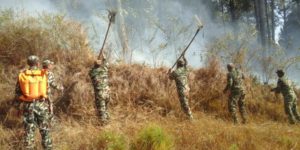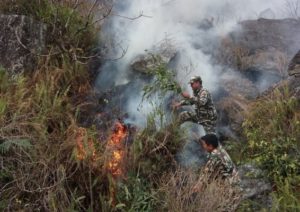
By Chun Bahadur Gurung, originally published at CIFOR’s Forests News
Forest fire, during dry season last year, hit the headlines in Nepal – the Himalayan country ravaged by a deadly earthquake in 2015. At least 15 deaths were reported and confirmed by multiple sources.
It was not the first time that Nepal experienced fire. In 2009, 13 armymen were killed in the central region of Ramechhap when they were dousing the flames.
Nepal suffers severely from crawling and crown fire. According to Shree Baral, Nepal’s Under-Secretary at the Department of Forest, 268,618 hectares of forest were damaged by the fires in the period from January-May 2016.
According to the Federation of Community Forestry Users Nepal (FECOFUN) – a national network of forest users in Nepal – 50 districts were affected and 12,000 community forests were damaged in 2016.
“What worried me the most was that the fires spread to the village. More than 419 households and 47 cattle sheds were damaged in Kapilbastu district alone,” said Subhash Devkota, the forest fire focal point at FECOFUN.
Bishwo Mani Acharya, the former District Forest Officer of Dadeldhura, estimated that 5,000 hectares of forest in Dadeldhura, a far western hill district in Nepal, were affected in 2016. He noted that 90 out of 455 community forests were damaged.

MONITORING AND REPORTING
Due to poor monitoring and reporting systems, it was challenging for authorities to collect details of the damage in a timely manner.
Today, approximately 35 percent of community forest users groups employ mobile forest guards, locally known as ghumtipalee. If fires break out, they report to the respective committees. As for government channels, forest offices throughout the country are their go-to mechanism to monitor and report incidents.
Additionally, a satellite-assisted monitoring system helps in site detection. According to Sudip Pradhan, Coordinator of the Regional Database at the International Center for Integrated Mountain Development (ICIMOD) – a regional intergovernmental learning and knowledge-sharing center – a well-functioning system is in place to detect forest fire incidents in Nepal.
The system uses Moderate-Resolution Imaging Spectroradiometre (MODIS) data, and disseminates the information to concerned authorities immediately through short message services (SMS) and emails. NASA’s Aqua and Terre satellites, which are equipped with MODIS sensors, fly over Nepal two times per day, enabling ICIMOD’s fire monitoring system to send fire alerts up to four times within a 24-hour time span.
However, some critics point out that it does not offer adequate verification opportunities.
“It is not the best, but it is better than nothing,” said Baral. “We at least can track the sites.”
CAUSES OF FIRE
According to a study conducted by the FAO, 95 percent of forest fires are manmade and can easily be prevented.
In Nepal, farmers traditionally use fire as a tool for burning agricultural residues– straw, stalks, husks, etc.- to prepare their farms for the next crop cultivation. Fires are thus likely to spread from farm to forest.
Other major causes are abandoned cooking fires and the carelessness of smokers. Firewood collectors sometimes throw burning butts into the jungle. These butts can catch fire on dried leaves and twigs during drought season.
Thus, most foresters and forest activists believe that raising awareness is key in the fight against forest fire.
“Despite a week-long awareness raising campaign led through local radio and newspapers, approximately 10,000 hectares of forest were still affected by forest fire in Piuthan alone,” said Dhananjaya Lamichhane, the former District Forestry Officer of Piuthan. “The forest fire claimed two lives and injured 13 others.”
Some community forest groups have since been given fire-fighting tools. But these tools are not optimal. Apasara Chapagain, a veteran forest conservation activist and former FECOFUN chair, said: “People are not using tools that they received. I strongly believe that awareness and preparation must be taken into account while developing a realistic anti-forest fire strategy.”
“In many cases, people cause fires in Nepal,” said Himlal Baral, a forest and environment scientist at the Center for International Forestry Research (CIFOR) who specializes in forest management, landscape restoration and ecosystem services.
“Learning successful lessons from community-based forestry, it is logical to practice community-based fire management in Nepal via engaging local communities from all aspects of fire planning and management.
“This requires the effective engagement of all stakeholders, especially local communities in fire management planning, which not only helps to understand the range of causes, but also their role in managing fire risk.”
LOOKING AHEAD
As a result of last year’s fires, Nepal’s Department of Forest has been implementing a forest fire prevention program as an extra effort in 36 affected districts, according to Mohan Kafle, the department’s newly-appointed forest fire focal point.
“The department under this program has allocated approximately USD 1 million for the current fiscal year,” he said.
The budget covers the construction of a forest fire control room, media mobilization, the construction of ponds and puddles, and other initiatives.
Nepal’s experience with this new program can serve other places with similar context and topography, as it is not the only country affected by recurring forest fire. In fact, an average of 19.8 million hectares of forests are reported to be significantly affected annually by forest fires, according to the FAO.











